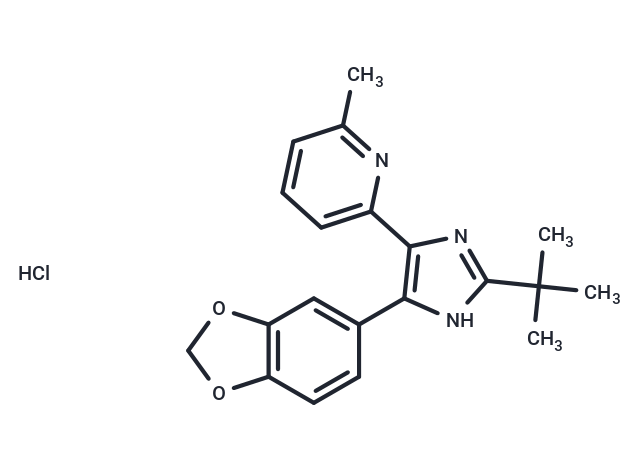Shopping Cart
Remove All Your shopping cart is currently empty
Your shopping cart is currently empty
SB-505124 hydrochloride (SB505124 hydrochloride) is an orally available, selective and potent inhibitor of TGF-β type I receptors (ALK4, ALK5, ALK7) with IC50 values of 129 nM and 47 nM for ALK4 and ALK5, respectively. SB-505124 hydrochloride inhibits IL-6 production by synovial explants and reduces Th17 differentiation in mice by decreasing Il17a and Rorc gene expression and IL-17 protein production.SB-505124 hydrochloride is used in the study of colorectal cancer.

| Pack Size | Price | USA Warehouse | Global Warehouse | Quantity |
|---|---|---|---|---|
| 1 mg | $35 | In Stock | In Stock | |
| 5 mg | $73 | In Stock | In Stock | |
| 10 mg | $105 | In Stock | In Stock | |
| 25 mg | $196 | In Stock | In Stock | |
| 50 mg | $328 | In Stock | In Stock | |
| 100 mg | $489 | - | In Stock |
| Description | SB-505124 hydrochloride (SB505124 hydrochloride) is an orally available, selective and potent inhibitor of TGF-β type I receptors (ALK4, ALK5, ALK7) with IC50 values of 129 nM and 47 nM for ALK4 and ALK5, respectively. SB-505124 hydrochloride inhibits IL-6 production by synovial explants and reduces Th17 differentiation in mice by decreasing Il17a and Rorc gene expression and IL-17 protein production.SB-505124 hydrochloride is used in the study of colorectal cancer. |
| In vitro | METHODS: Rabbit subconjunctival fibroblasts were incubated with 10 μM SB-505124 or 0.04% MMC and then incubated with or without TGF-β2 (2 ng/ml) in 12-well plates for 48 h. The effects of ALK-5 inhibitor SB-505124 on TGF-β2-induced downstream effects were analyzed by Western blotting. RESULTS: The levels of pSmad2, CTGF, and α-SMA in rabbit subconjunctival fibroblasts treated with SB-505124 were decreased in a concentration-dependent manner. [3] |
| In vivo | SB-505124 (5 mg/kg; i.p.) alone does not elicit any response in C57Bl6 mice bearing A549 xenografts. However, when combined with a single dose of Carboplatin (60 mg/kg), SB-505124 induces sustained therapeutic effects in five subjects, eliminating the need for ongoing maintenance therapy. This synergy presents a potent treatment strategy without continuous intervention in the specified animal model, highlighting its potential efficacy. |
| Synonyms | SB505124 hydrochloride, SB 505124 hydrochloride |
| Molecular Weight | 371.86 |
| Formula | C20H22ClN3O2 |
| Cas No. | 356559-13-2 |
| Smiles | Cl.N=1C(=CC=CC1C)C=2N=C(NC2C=3C=CC=4OCOC4C3)C(C)(C)C |
| Relative Density. | no data available |
| Color | Yellow |
| Appearance | Solid |
| Storage | keep away from moisture | Powder: -20°C for 3 years | In solvent: -80°C for 1 year | Shipping with blue ice/Shipping at ambient temperature. | |||||||||||||||||||||||||||||||||||
| Solubility Information | Methanol: 120 mg/mL (322.7 mM), Sonication is recommended. DMSO: 40 mg/mL (107.57 mM), Sonication is recommended. | |||||||||||||||||||||||||||||||||||
| In Vivo Formulation | 10% DMSO+40% PEG300+5% Tween 80+45% Saline: 2 mg/mL (5.38 mM), Sonication is recommended. Please add the solvents sequentially, clarifying the solution as much as possible before adding the next one. Dissolve by heating and/or sonication if necessary. Working solution is recommended to be prepared and used immediately. The formulation provided above is for reference purposes only. In vivo formulations may vary and should be modified based on specific experimental conditions. | |||||||||||||||||||||||||||||||||||
Solution Preparation Table | ||||||||||||||||||||||||||||||||||||
DMSO/Methanol
| ||||||||||||||||||||||||||||||||||||
| Size | Quantity | Unit Price | Amount | Operation |
|---|

Copyright © 2015-2025 TargetMol Chemicals Inc. All Rights Reserved.